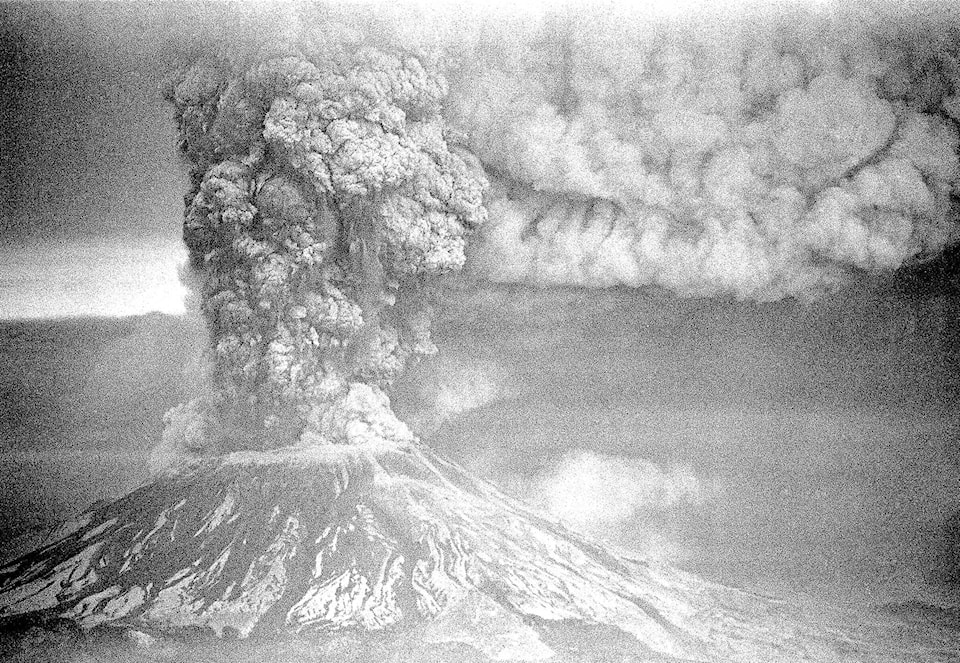Back on May 18, 1980, the eruption of Mount St Helens quite literally shook the world. The eruption killed 57 people, destroyed a significant portion of the mountain’s peak and sent ash and debris raining onto homes, roads and people up to hundreds of miles away.
There are museums and monuments dedicated to the disaster and remembrance ceremonies are held every year
Though this year’s 40th anniversary plans were interrupted on the other side of the border, members of the Observer readership took time to share some of their experiences from that day a little more than 40 years ago.
Diana Ouwerkerk-Campbell was in Abbotsford that sunny, Sunday morning.
RELATED: Virus interrupts St. Helens eruption anniversary plans
“I remember it vividly,” she said. “There was an eerie silence where even the birds stopped singing before a low rumble was heard.”
“It was devastating,” Julia Gaskin said. “I remember the day because it was also my dad’s 65th birthday, the day he retired. Even now, I think of the two events together.”
Ingrid Frost recalled living in Delta at the time of the eruption, which is roughly 500 kilometres away from the mountain.
“My husband was putting siding on our house when the ash started falling,” she recalled. “It was difficult to breathe and the ash was everywhere!”
Rilla Apostolakis was in Harrison Hot Springs at the time.
“I was eight, and I remember playing in my grandpa’s yard when I heard the boom.”
READ ALSO: Volcano erupts near Manila; villagers flee, airports shut
“I heard the blast twice while on the phone,” Hilary Hurst Shantz added. “I thought a building nearby blew up in Agassiz. Scary.”
Chad Hedrick was in Tacoma when the eruption happened, roughly three hours by car.
“The city of Tacoma was in the dark that day with the ash blocking the sunlight completely,” he remembered. “The famous last words of the scientist on the ridge just across from the mountain were ‘Vancouver, Vancouver this is it!’ He was radioing to Vancouver, Washington that the blast was imminent. The ash from [the eruption] circled the earth within a week. The dirt and debris that washed down the Columbia River made the shipping lanes too shallow to use within 24 hours.”
Carole Horst was even closer in Portland, Oregon, about 114 kilometres away.
“We were going to head home through the area of ash fallout,” she said. “Instead, we rushed out of the hotel and hit the I5. The tension in the car was palpable. One minute, the highway was closed, then all of the sudden, it was opened with cops telling you to drive as fast as you can. We had ash all over the car when we got home to Chilliwack.”
Andrea Young was dangerously close at 20 kilometres, but disconcertingly didn’t feel the effects until ash started falling.
“We didn’t feel or hear a thing – just ash everywhere,” Young said. “It was so soft. We got an ice cream pail of it.”
Monika Stolte was living in Lethbridge, Alberta at the time, and even more than 1,000 kilometres away, lawns and vehicles were covered with fine ash.
“I have often taken the airline that flies right over Mount St. Helens, the top of which is blown off and is still an eerie sight,” she said. “A crater.”
Still further out, Frank Granovski, who was 26 at the time, was living in Winnipeg, 2,360 kilometres, 25 hours by car, away.
“It blanketed Winnipeg three times [in ash],” he said. “The first time was the worst.”
The Mount St. Helens eruption, a climax of a series of smaller eruptions through the weeks leading up to it, sent ash hurtling up 24,000 metres that scattered thousands of kilometres throughout the Pacific Northwest and beyond. The eruption triggered the largest landslide in recorded history and utterly destroyed forested space 450 square kilometres surrounding the mountain.
The Associated Press contributed to this report.
adam.louis@ahobserver.com
Like us on Facebook and follow us on Twitter
Want to support local journalism during the pandemic? Make a donation here.
